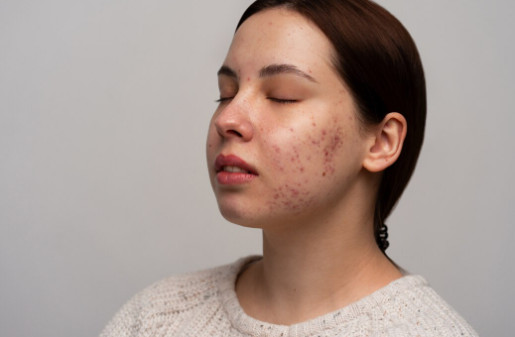What Is Lymphatic Acne? Causes, Symptoms, and Treatment Options
Acne is one of the most common skin concerns worldwide, but not all acne is the same. While most people are familiar with hormonal acne or bacterial acne, there’s another type that is less understood—lymphatic acne. This condition is closely tied to the lymphatic system, which plays a vital role in detoxification and immune support.
If you’ve ever experienced stubborn, swollen, or painful acne that doesn’t respond to typical treatments, lymphatic acne might be the culprit. In this article, we’ll break down everything you need to know about lymphatic acne—its causes, symptoms, and the best treatment options to help you manage it effectively.
Understanding Lymphatic Acne
The lymphatic system is a complex network of lymph nodes, vessels, and fluids that help the body flush out toxins, waste, and pathogens. It works closely with the immune system to maintain balance and fight infections.
When the lymphatic system becomes sluggish or blocked, toxins can build up in the body. This buildup often manifests on the skin, the body’s largest detoxification organ, leading to what many call lymphatic acne.
Unlike typical acne that’s caused by clogged pores or bacteria, lymphatic acne is more deeply connected to internal imbalances and poor lymphatic circulation.
Causes of Lymphatic Acne
Lymphatic acne develops when the lymphatic system cannot effectively eliminate toxins. Several factors may contribute to this dysfunction:
1. Poor Lymphatic Drainage
The lymphatic system doesn’t have a natural pump like the heart. Instead, it relies on body movement, breathing, and hydration to circulate lymph fluid. Sedentary lifestyles, dehydration, or chronic stress can cause sluggish lymph flow, leading to toxin buildup and acne.
2. Diet and Toxin Overload
Processed foods, excessive sugar, alcohol, and refined carbohydrates increase inflammation in the body. A diet low in nutrients can also strain the lymphatic system, resulting in toxin accumulation and skin flare-ups.
3. Hormonal Imbalances
Fluctuations in hormones, particularly during menstruation, pregnancy, or stress, can affect lymphatic function. Estrogen and progesterone imbalances often worsen acne symptoms by increasing sebum (oil) production.
4. Chronic Stress
Stress releases cortisol, a hormone that directly impacts immunity and lymphatic circulation. Over time, chronic stress weakens the body’s detoxification pathways, making acne more severe.
5. Dehydration
Since lymph fluid is mostly water, inadequate hydration can slow down circulation. This not only impacts skin hydration but also reduces the body’s ability to flush out toxins efficiently.
6. Environmental Factors
Exposure to pollution, chemicals in skincare products, and even lack of fresh air can overload the lymphatic system with external toxins, contributing to acne flare-ups.
Symptoms of Lymphatic Acne
Identifying lymphatic acne can be tricky because it may resemble other acne types. However, there are some distinctive signs that indicate your breakouts could be linked to lymphatic congestion:
- Deep, painful cysts – Unlike surface-level pimples, lymphatic acne tends to form large, swollen bumps that feel tender to the touch.
- Swelling and puffiness – Breakouts are often accompanied by facial puffiness, particularly around the cheeks, jawline, and under the eyes.
- Slow healing time – Pimples take longer to heal, leaving behind scars or dark spots.
- Recurring breakouts in specific areas – Lymphatic acne often appears around the jawline, chin, and neck, areas where lymph nodes are concentrated.
- Worsens with fatigue or illness – Since the lymphatic system is tied to immunity, acne flare-ups may worsen when you’re run down or fighting an infection.
- Accompanied by other detox issues – You may also notice bloating, frequent colds, or sluggish energy, all signs of poor lymphatic function.
How Lymphatic Acne Differs from Other Acne Types
To understand lymphatic acne better, it helps to compare it with more common acne forms:
- Hormonal acne: Triggered by hormone fluctuations; appears mostly around the jawline and chin but is tied to oil production and clogged pores.
- Bacterial acne: Caused by overgrowth of acne-causing bacteria (Cutibacterium acnes); usually includes whiteheads, blackheads, and pustules.
- Fungal acne: Results from yeast imbalance; looks like uniform, itchy bumps, often on the forehead or chest.
- Lymphatic acne: Rooted in poor detoxification and lymphatic stagnation; appears as painful, swollen cysts with slow healing times.
Recognizing these differences can help you pursue the most effective treatment for your skin.
Treatment Options for Lymphatic Acne
Managing lymphatic acne requires a holistic approach. Since the root cause lies within the lymphatic system, treatment involves both internal and external care.
1. Lifestyle Changes for Better Lymphatic Flow
- Exercise regularly: Activities like yoga, stretching, rebounding (mini trampoline), or even brisk walking stimulate lymphatic drainage.
- Stay hydrated: Drink at least 2–3 liters of water daily to keep lymph fluid moving.
- Deep breathing: Practicing diaphragmatic breathing can improve lymph circulation and reduce stress.
2. Dietary Adjustments
- Increase whole foods: Eat more fruits, vegetables, and fiber-rich foods to support detoxification.
- Reduce sugar and processed foods: These increase inflammation and strain the lymphatic system.
- Incorporate anti-inflammatory foods: Ginger, turmeric, green tea, and omega-3-rich foods like salmon or chia seeds can soothe the skin.
3. Detoxification Support
- Dry brushing: Using a natural bristle brush on the skin before showering stimulates lymphatic drainage and exfoliates dead skin.
- Lymphatic massage: Gentle facial or body massage techniques help move lymph fluid and reduce puffiness.
- Sweating: Saunas, steam rooms, or exercise-induced sweating assist in flushing toxins through the skin.
4. Skincare for Lymphatic Acne
While the focus should be on internal health, a gentle skincare routine is essential:
- Use non-comedogenic cleansers to avoid pore clogging.
- Apply soothing ingredients like aloe vera, niacinamide, or chamomile to reduce inflammation.
- Avoid harsh scrubs or overly drying products, as they can irritate the skin further.
5. Medical and Professional Treatments
If lymphatic acne persists, consult a dermatologist or holistic practitioner. Treatment options may include:
- Topical retinoids to speed up cell turnover.
- Prescription anti-inflammatories for severe swelling.
- Hormonal therapies (if hormonal imbalance contributes).
- Professional lymphatic drainage therapy, a specialized massage designed to improve circulation.
6. Stress Management
Since stress is a major trigger, incorporating relaxation techniques can make a significant difference. Options include:
- Meditation or mindfulness practices.
- Yoga or tai chi.
- Journaling and gratitude exercises.
- Adequate sleep (7–9 hours per night).
Prevention Tips for Lymphatic Acne
Once your acne improves, preventing future flare-ups is key. Here are some tips to keep your lymphatic system healthy:
- Maintain daily movement – Avoid long periods of sitting without stretching or walking.
- Eat a balanced diet – Focus on whole, nutrient-dense foods.
- Limit toxin exposure – Choose natural skincare and cleaning products when possible.
- Support gut health – Probiotics and prebiotics can improve digestion and reduce toxin buildup.
- Stay hydrated consistently – Make water a priority throughout your day.
When to See a Doctor
While many cases of lymphatic acne can be improved with lifestyle changes, professional help is necessary if:
- Acne is extremely painful or cystic.
- You experience scarring or dark spots after healing.
- Lifestyle and skincare changes do not bring improvement.
- Symptoms of lymphatic dysfunction (chronic swelling, fatigue, frequent infections) are severe.
A healthcare provider can run tests to check for underlying conditions such as hormonal imbalances, immune deficiencies, or lymphatic disorders.
Final Thoughts
Lymphatic acne is more than just a skin problem—it’s a sign that your body’s detoxification system needs support. Unlike typical acne, it is rooted in poor lymphatic circulation and toxin buildup. By focusing on a holistic approach—improving diet, staying active, reducing stress, and supporting lymphatic flow—you can significantly reduce flare-ups and restore healthier skin.
Remember, clear skin often reflects a healthy inner system. Supporting your lymphatic health not only helps manage acne but also boosts overall energy, immunity, and well-being.










Leave a Reply
Want to join the discussion?Feel free to contribute!